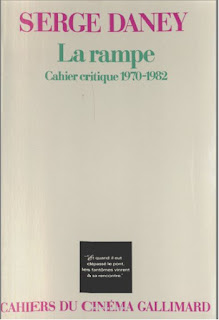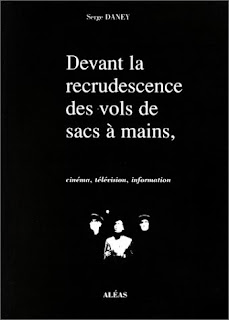Gray matter - Jaws by Steven Spielberg
Jaws obeys the rules of how a typical disaster film is set on its course.
1. Opening scene. At night, on a beach, a group of youths sing, drink and smoke. Tipsy (stoned?), two of them go take a skinny-dip expecting much pleasure. Offended, the sea dispatches its shark with its teeth*. The girl who “was the first one,” and who swims elegantly on the film poster, will be reduced to a disgusting pile of flesh in the morning. From then on, all sexual relations are suspended. In a grotesque scene, the cop’s (Roy Scheider) wife suggests to her husband “to get drunk and fool around”. The cop feels queasy and the audience laughs: doesn’t she know, the fool, that she could be “the second one”? So sexual relations are suspended until the clever but abject beast (gray matter, nothing but gray matter) explodes into a reddish powder. The shark is a paper tiger.
2. If there is such a thing as a link between violence and pornography, it is that they exclude one another in the logic of disaster films (which is also the logic of US imperialism: the politics of “the worse, the better”). If there is violence, there cannot be pornography, since it is the threat of pornography that violence is warding off. Already, in the stupid The Towering Inferno, it is because a (slightly effeminate) rich kid engages in careless flirting that he commits the criminal negligence causing the disaster. He will die as a result (not before proving his incurable spinelessness), as will an illegitimate couple secretly making love even though the fire was already raging and the audience had understood that it wasn’t dealing with a logic of fooling around anymore, but with an escalation of violence.
Not any violence though. Fire, jaws, quaking grounds help bind the community together again. Not sex (which only binds two people) but paranoid sublimation (which scares a lot of people). In other words – and this is not the least worrying bit of the story – children sin and parents pay the price.
3. The suspended sexual relations make way for a “three men in a boat” setup bordering on homosexual comradeship, with noble ends and tough guy violence. We know that, in American cinema, this comradeship is defined by the exclusion of two despised groups: women and politicians (thought to have access to suspicious pleasures, in the view of real men). It’s also a question of sealing a triple alliance between the hunter, the scientist and the cop. And this alliance has a class dimension: Quint, the working-class man ill-suited to society (played by the Shakespearian actor Robert Shaw), and two figures of middle class (the modest and idealistic academic – Richard Dreyfus – and an almost failed cop), fight against the rot of money: profit-hungry property developers, irresponsible mass swimmers, a corrupt mayor. And it’s also about binding the audience in the film theatre, to transform it into a petrified collective, bombarded by an advertising campaign that makes them as incapable of escaping Jaws (the film) as the film extras are of escaping the jaws of the shark.
4. This “Boo! Scare me!” is therefore heavily loaded with the question of “How to reassure the masses?” and “What is the price to pay?”. A misplaced desire (the youths that smoked on the beach and that the fiction will quickly get rid of) will be substituted by a more socialising desire, a desire to end the horror and to return to normality. That is the function of disaster films. But it is not the only one: for what is to be desired, by the same token, is the norm. It is in this regard that this cinema borders on fascism.
What scared more than three hundred thousand spectators in one week? And what are they getting reassured about? About the staging of a violence that – as Alain Bergala says quite rightly – “guarantees the very conditions of the spectator’s pleasure and his future support for every form of counter-violence”.
It’s the perennial cry of the sergeant major saying: “I only want to see one head!” Nothing must stand out: a sleek, full and homogenous body (military or social). A body that can be compared to a loop that closes itself except in one place where it gapes. This is where the shark shows up: it is what Lacan defines as the model of the fish trap, the obturator, the object a. Who is the shark? Nothing more than the actualisation – arriving like a hallucination from outside the fish trap – of the fact that something is rotten inside and attracting the fish. This something is the enemy within, meaning anything capable of pleasure. The supposed pleasure of the youths at the beginning, the real pleasure of the asocial duovidual composed of the hunter and the scientist. For nothing compels Quint to persevere with the hunt except the fatal outcome that he surmises: to be incorporated by the great white. Nothing compels the scientist to make a copy of the Quattrocento cube (the cage) underwater, right under the shark’s nose. He must be a cinephile. Neither he nor Quint will kill the beast.
5. A normative fantasy must be organised with a mise en scene. Quite simply, it consists in filming everything (events, extras) from two – and only two – points of views: that of the hunter and that of the hunted. There is no other point of view (spatial, moral or political), no other place for the camera, and therefore for the spectator, than this double position. Some talk lightly about “identification” in the cinema. They haven’t noticed that in this kind of film, the identification is with the couple hunter/hunted, with its specular oscillation, a short-circuit between knowledge and point of view, a loss of any point of reference, getting under the other’s gray skin, in summary everything leading to a complete removal of any responsibility. In the pulsation of this double point of view, the camera is with the child who swims and for whom the shark is only this black rectangle speeding by, and it is, in the next shot, with the shark for whom the leg of the child is just what sticks out below the water surface.
* Reference to the French title of the film: Les dents de la mer (the sea’s teeth) [translator’s note].
First published as “The screen of fantasy (2)” in Cahiers du Cinéma, issue 265, March-April 1976. Reprinted in La Rampe, cahier critique 1972-1982, Cahiers du cinéma – Gallimard, 1983. Translated by Laurent Kretzschmar and Srikanth Srinivasan.







